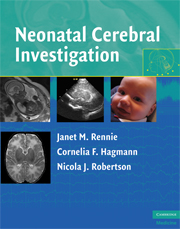Book contents
- Frontmatter
- Contents
- List of contributors
- Preface
- Acknowledgements
- Glossary and abbreviations
- Section I Physics, safety, and patient handling
- Section II Normal appearances
- Section III Solving clinical problems and interpretation of test results
- 7 The baby with a suspected seizure
- 8 The baby who was depressed at birth
- 9 The baby who had an ultrasound as part of a preterm screening protocol
- 10 Common maternal and neonatal conditions that may lead to neonatal brain imaging abnormalities
- 11 The baby with an enlarging head or ventriculomegaly
- 12 The baby with an abnormal antenatal scan: congenital malformations
- 13 The baby with a suspected infection
- 14 Postmortem imaging
- Index
- References
8 - The baby who was depressed at birth
from Section III - Solving clinical problems and interpretation of test results
Published online by Cambridge University Press: 07 December 2009
- Frontmatter
- Contents
- List of contributors
- Preface
- Acknowledgements
- Glossary and abbreviations
- Section I Physics, safety, and patient handling
- Section II Normal appearances
- Section III Solving clinical problems and interpretation of test results
- 7 The baby with a suspected seizure
- 8 The baby who was depressed at birth
- 9 The baby who had an ultrasound as part of a preterm screening protocol
- 10 Common maternal and neonatal conditions that may lead to neonatal brain imaging abnormalities
- 11 The baby with an enlarging head or ventriculomegaly
- 12 The baby with an abnormal antenatal scan: congenital malformations
- 13 The baby with a suspected infection
- 14 Postmortem imaging
- Index
- References
Summary
Clinical presentation of birth depression
When faced with the dire emergency of a baby who is white, floppy, not breathing and whose heart is beating very slowly, the attending neonatologist cannot spend time quizzing the mother about her family history, pregnancy and labor, and nor should she. Her first priority must be to resuscitate the baby along the usual lines, remembering that a baby who does not respond may have lost blood, be suffering from overwhelming sepsis, have endured a period of hypoxic ischemia, or have a myopathy or spinal cord damage. The one investigation that must be requested in the heat of the battle is a cord pH, preferably from both an umbilical artery and the vein. These results will be invaluable in a later analysis of the case, and in an emergency a double-clamped section of cord can be kept on one side and analyzed up to 60 min later without invalidating the result [1]. Normal scalp and cord blood pH values are given in Table 8.1. The most common cause of birth depression at term is hypoxic ischemia sustained during labor, and in preterm babies the most common cause is respiratory distress syndrome (RDS). Other causes are listed in Table 8.2, and sepsis is an important possibility.
Investigation of the baby with birth depression
Once the baby's condition is stable there will be time to gather more information.
- Type
- Chapter
- Information
- Neonatal Cerebral Investigation , pp. 130 - 172Publisher: Cambridge University PressPrint publication year: 2008
References
- 1
- Cited by



